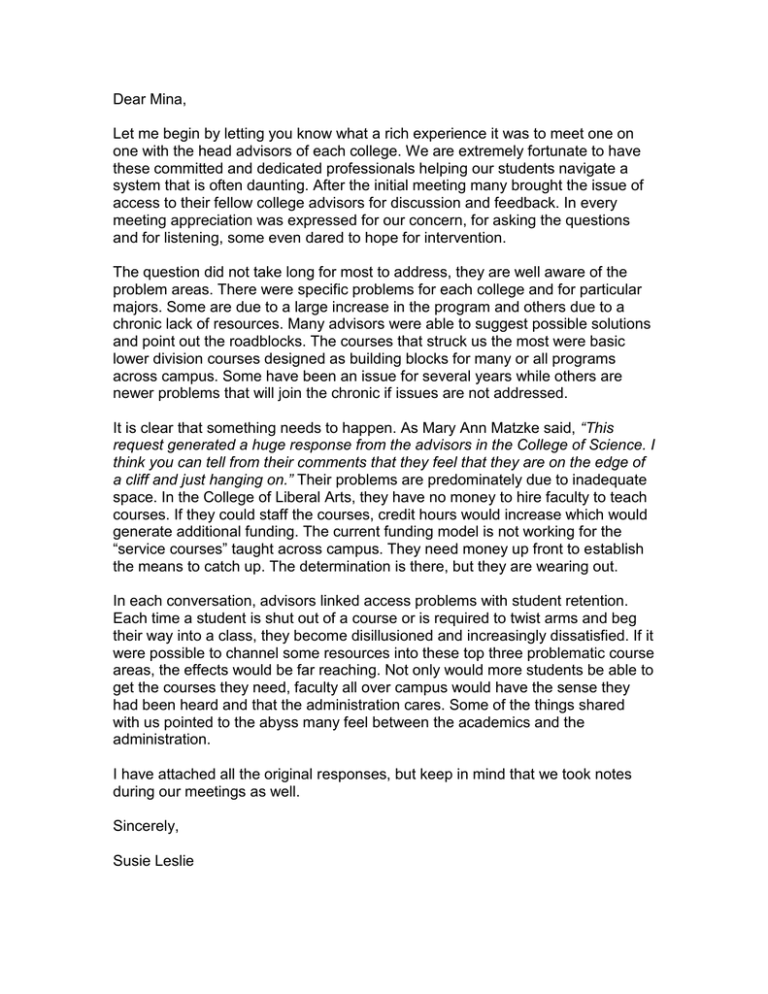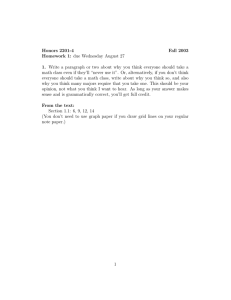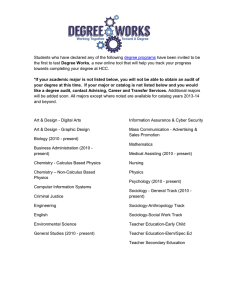Dear Mina,
advertisement

Dear Mina, Let me begin by letting you know what a rich experience it was to meet one on one with the head advisors of each college. We are extremely fortunate to have these committed and dedicated professionals helping our students navigate a system that is often daunting. After the initial meeting many brought the issue of access to their fellow college advisors for discussion and feedback. In every meeting appreciation was expressed for our concern, for asking the questions and for listening, some even dared to hope for intervention. The question did not take long for most to address, they are well aware of the problem areas. There were specific problems for each college and for particular majors. Some are due to a large increase in the program and others due to a chronic lack of resources. Many advisors were able to suggest possible solutions and point out the roadblocks. The courses that struck us the most were basic lower division courses designed as building blocks for many or all programs across campus. Some have been an issue for several years while others are newer problems that will join the chronic if issues are not addressed. It is clear that something needs to happen. As Mary Ann Matzke said, “This request generated a huge response from the advisors in the College of Science. I think you can tell from their comments that they feel that they are on the edge of a cliff and just hanging on.” Their problems are predominately due to inadequate space. In the College of Liberal Arts, they have no money to hire faculty to teach courses. If they could staff the courses, credit hours would increase which would generate additional funding. The current funding model is not working for the “service courses” taught across campus. They need money up front to establish the means to catch up. The determination is there, but they are wearing out. In each conversation, advisors linked access problems with student retention. Each time a student is shut out of a course or is required to twist arms and beg their way into a class, they become disillusioned and increasingly dissatisfied. If it were possible to channel some resources into these top three problematic course areas, the effects would be far reaching. Not only would more students be able to get the courses they need, faculty all over campus would have the sense they had been heard and that the administration cares. Some of the things shared with us pointed to the abyss many feel between the academics and the administration. I have attached all the original responses, but keep in mind that we took notes during our meetings as well. Sincerely, Susie Leslie Results of Access Inquiry to College Head Advisors*, November, 2004 The worst cases in approximate order of severity: COMM 111 – Public Speaking COMM 114 – Argumentation and Critical Discourse COMM 218 – Interpersonal Communication Virtually no freshmen or sophomores can register for these courses. Some students can’t get in until their senior year. The intent of these courses is to develop presentation skills students will use in future courses. There is little opportunity for OSU students to further develop oral communication skills if they cannot get into a speech course until their junior or senior year CH 221/222/223 – General Chemistry CH 331/332 – Organic Chemistry CH 337 – Organic Chemistry Lab Chemistry is a huge problem. The most pressing issue is space. They have had a 50% increase in students taking general chemistry since 1997, and the number of chemistry majors has increased from 60 to 190 in four years. No new lab space has been created and the number of faculty has decreased. CH 221/222/223 and CH 331/332 are required by many majors and many upper division courses are dependent on their content. Students must wait a year or more to take the lab after completing the lecture series. Currently there is a backlog of over 200 students needing the lab. Another concern expressed is that some students repeat these courses to improve their grade, thus shutting out new students. The access problems in chemistry courses will initially result in delaying students a year for their class and eventually the time to degree will increase from four to five years. SPAN 111/211/311 – 1st, 2nd, 3rd year Spanish All languages are a problem, but Spanish is by far the worst. Several advisors noted that many students are admitted to OSU with a deficiency in language. This is a requirement by OUS that states all entering students must have two years of a second language in high school. This remains on their transcript until they take two terms of a college-level language. This access problem is in opposition to the greater goals of OSU to provide an international education. It is also a setback for those wanting to live and work in the Northwest where the need for Spanish is ever increasing. The point was made that to fix this problem, foreign languages need to be able to plan ahead to hire the instructors; language instructors aren’t easy to find locally. The following courses represent serious problematic situations, but they are not as universal across campus. WR 121 – English Composition WR 327 – Technical Writing The problems here are much the same as those for COMM courses. WR 121 is a skill building class. WR 327 is a requirement for all COE students to move forward. PH 201 – General Physics PH 211 – General Physics with Calculus These courses always fill to capacity and they are seen as a future big problem area. Again, when a student is shut out, it may delay graduation or entry into a Professional School. MTH 251 – Differential Calculus Required by many majors and regularly fills. For engineering students this course cannot be delayed. It is a prerequisite into all future engineering courses. HSTS 415 – History of Evolution Science This is a WIC and Synthesis course used by many life science majors. It is always over-subscribed. It is larger than is reasonable for a WIC course and should be offered more than once a year. BI 211H – Honors Biology The difficulty is not just resources, but availability of staff that meet the constraints of the Honors program staffing. Attention needs to be paid as the Honors College is a recruiting tool for OSU, but students can’t get into Honors Biology. HST (capstone course problematic due to staffing constraints) ART (closed to non-majors, multi-media minors and DHE majors have difficulty getting required courses) DHE (78% increase in majors in last five years, foundation courses are backlogged affecting graduation) SOC (unable to offer a minor with academic integrity due to staffing, major limited to 60 majors/year, only majors receive theory and methods courses) COS (many courses are problematic, see attachments) *Responding advisors, Business Engineering Forestry HHS CLA Pharmacy COS Vet Med (reported they are only a graduate program and therefore did not have problems) UESP


